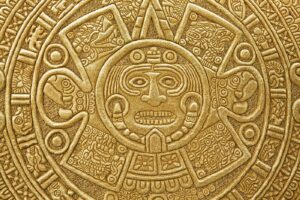Playa del Carmen, located on Mexico’s Yucatán Peninsula along the Riviera Maya, has evolved dramatically from its ancient roots to the vibrant tourist hotspot it is today. Though it’s now celebrated for its beaches, nightlife, and eco-tourism, Playa del Carmen has a rich history shaped by indigenous cultures, European colonization, and modern tourism. This journey reveals much about the unique history of Playa del Carmen that shaped this destination.

Ancient Beginnings: Maya Civilization
The history of Playa del Carmen begins with the Maya civilization, which flourished in the Yucatán Peninsula for centuries before the arrival of Europeans. The Maya were a highly advanced society with achievements in mathematics, astronomy, and agriculture. They established numerous trade routes and settlements throughout the region, including Playa del Carmen, known then as Xaman Ha, meaning “waters of the north.”
Xaman Ha served as a coastal stopover for Maya pilgrims traveling to the island of Cozumel. These pilgrims worshiped Ix Chel, the goddess of fertility, and would journey across the sea to seek her blessings. Xaman Ha’s strategic location along trade routes also contributed to its importance as a center for exchanging goods like jade, cacao, obsidian, and textiles. Evidence of the Maya presence can still be seen in nearby ruins such as Tulum, a well-preserved walled city only about an hour south of Playa del Carmen, and the impressive Coba pyramids further inland.
Spanish Colonization and Decline
The arrival of Spanish explorers in the 16th century brought significant changes and challenges to the Maya people of the Yucatán Peninsula. Spanish conquistadors, led by figures like Francisco de Montejo, were focused on controlling the wealth and land of the Maya. They introduced new religious, cultural, and agricultural practices to the region, often imposing them on the indigenous populations. Many Maya communities resisted the Spaniards, and conflicts persisted well into the colonial period. This had a huge impact on the history of Playa del Carmen.
The diseases brought by the Europeans, including smallpox and influenza, devastated the native populations. This, coupled with forced labor and the suppression of Maya culture, led to a decline in Maya societies, including the coastal settlements like Xaman Ha. By the 17th century, the Yucatán Peninsula was largely under Spanish control, though many Maya groups continued to resist Spanish rule through uprisings and rebellions well into the 19th century.
The Caste War and Maya Resurgence
One of the most significant parts in the history of Playa del Carmen was uprisings was the Caste War of Yucatán (1847–1901), a major rebellion by the indigenous Maya against the Hispanic populations and government forces. The Maya people fought to reclaim their land and freedom from the oppressive systems that marginalized them. Although the rebellion was eventually suppressed, it significantly affected the region, particularly the eastern parts of the Yucatán Peninsula. The conflict also led to the establishment of semi-autonomous Maya communities in the eastern Yucatán, some of which remained outside government control until the early 20th century.
During this period, Playa del Carmen remained a small fishing and farming village. The town’s isolation kept it relatively untouched by the events happening further inland, though it retained a strong connection to its Maya heritage and culture.

Development and the Birth of Tourism
Playa del Carmen remained a quiet fishing village until the latter half of the 20th century, when developments in infrastructure and tourism began transforming the region. The construction of Cancun in the 1970s as a government-supported tourist destination brought attention to the natural beauty of the Riviera Maya. As Cancun’s popularity grew, travelers began exploring nearby areas, including Playa del Carmen. Because the history of Playa del Carmen is so rich, many history enthusiasts consider this a very important and significant destination. Many developers have sought to build properties to rent due to this increase in tourism.
In the early 1990s, Playa del Carmen was still a modest town, but it began attracting independent travelers and backpackers drawn to its relaxed atmosphere, beautiful beaches, and proximity to Cozumel, a popular scuba diving destination. Around this time, the ferry service between Playa del Carmen and Cozumel was established, further boosting its accessibility.
The development of the Quinta Avenida (Fifth Avenue) as a pedestrian-friendly street lined with restaurants, shops, and bars created a lively focal point for visitors. This street, still central to Playa del Carmen today, became a major attraction, offering visitors a mix of local and international cultures. Real estate development surged, with hotels, resorts, and residential buildings springing up along the coast and attracting an increasing number of international tourists.
Ecotourism and Environmental Awareness
As Playa del Carmen grew, the town’s popularity began drawing attention to environmental concerns. The Riviera Maya is home to unique ecosystems, including coral reefs, cenotes (natural freshwater sinkholes), and a diverse range of flora and fauna. Recognizing the need to protect these natural treasures, ecotourism initiatives were introduced in the area. Resorts began implementing sustainable practices, and nature reserves and parks such as Xcaret, Xel-Ha, and Rio Secreto were established to offer visitors eco-friendly experiences that celebrated local wildlife and ecosystems.
The Mesoamerican Barrier Reef, the second-largest coral reef system in the world, lies just off the coast of Playa del Carmen and is a significant draw for scuba divers and snorkelers. However, the growing tourist activity raised concerns about reef health. Conservation organizations and the local government took steps to promote responsible tourism practices, ensuring that visitors could enjoy the reef without damaging it.
Playa del Carmen Today: A Global Destination
Today, Playa del Carmen is a cosmopolitan destination that attracts millions of visitors each year. The town’s diverse population includes people from all over the world who have relocated to enjoy its beautiful beaches, warm climate, and relaxed lifestyle. It has become a haven for digital nomads, expatriates, and artists, contributing to an international and vibrant atmosphere. The local culture remains rooted in Maya heritage, though it has been influenced by global trends, especially in cuisine, fashion, and entertainment.
Playa del Carmen is known for its annual events like the Riviera Maya Jazz Festival and Day of the Dead celebrations, which attract international performers and visitors. The town’s nightlife, particularly on Fifth Avenue, offers a range of experiences from laid-back beach bars to upscale clubs. Boutique hotels, luxury resorts, and eco-friendly accommodations cater to a variety of travelers, further contributing to its diverse tourism industry.
Challenges and the Future
Despite its growth and popularity, Playa del Carmen faces challenges, including environmental pressures, infrastructure demands, and social impacts from rapid development. The town’s rapid expansion has strained resources and increased waste, prompting discussions on sustainable development practices to preserve the local environment and culture. The history of Playa del Carmen is one of pain and sacrifice. Therefore, the indigenous people are very protective of certain sites and structures.
In recent years, the local government and various organizations have implemented initiatives to address these issues. Programs to protect the reefs, regulations on waste disposal, and sustainable building practices are part of ongoing efforts to mitigate the environmental impact of tourism. Efforts are also underway to celebrate and preserve Maya culture, ensuring that this rich heritage remains a visible and vital part of Playa del Carmen’s identity.
Conclusion
The history of Playa del Carmen is a testament to the resilience and adaptability of the region and its people. From its early days as a Maya pilgrimage site to its modern status as an international tourist destination, Playa del Carmen has undergone dramatic transformations while retaining a connection to its cultural roots. As it continues to evolve, the town faces the challenge of balancing growth with sustainability and cultural preservation. For visitors, Playa del Carmen offers more than beautiful beaches and lively nightlife; it presents an opportunity to connect with a place rich in history, culture, and natural beauty. The town’s journey from Xaman Ha to Playa del Carmen is a fascinating story of change, resilience, and the enduring allure of the Riviera Maya.

